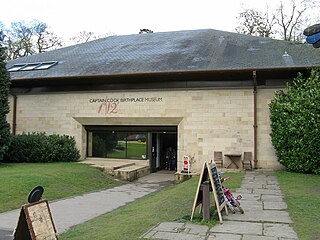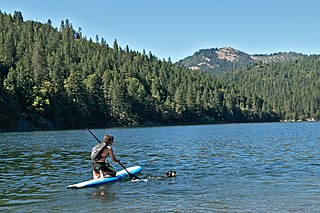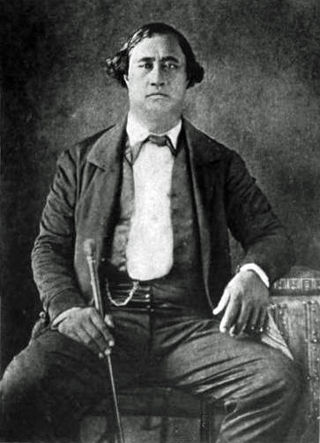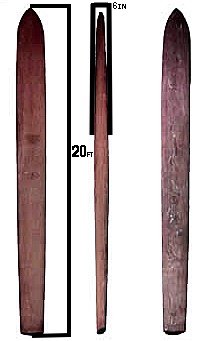
Duke Paoa Kahinu Mokoe Hulikohola Kahanamoku was a Hawaiian competition swimmer who popularized the sport of surfing. A Native Hawaiian, he was born to a minor noble family less than three years before the overthrow of the Hawaiian Kingdom. He lived to see the territory's admission as a state, and became a United States citizen. He was a five-time Olympic medalist in swimming, winning medals in 1912, 1920 and 1924.

Captain James Cook was a British explorer, cartographer and naval officer famous for his three voyages between 1768 and 1779 in the Pacific Ocean and to New Zealand and Australia in particular. He made detailed maps of Newfoundland prior to making three voyages to the Pacific, during which he achieved the first recorded European contact with the eastern coastline of Australia and the Hawaiian Islands and the first recorded circumnavigation of New Zealand.

Surfing is a surface water sport in which an individual, a surfer, uses a board to ride on the forward section, or face, of a moving wave of water, which usually carries the surfer towards the shore. Waves suitable for surfing are primarily found on ocean shores, but can also be found in standing waves in the open ocean, in lakes, in rivers in the form of a tidal bore, or in wave pools.

Braunton is a large village, civil parish, ecclesiastical parish and former manor in Devon. The village is situated 5 miles (8 km) west of Barnstaple. It is one of the largest villages in Devon with a population at the 2021 census of 10,217 people. There are two electoral wards. Their joint population at the above census was 8,218. Within the parish is the fertile, low-lying Braunton Great Field, which adjoins the undulating Braunton Burrows, the Core Area in North Devon Biosphere Reserve, the largest psammosere in England. It confronts the Atlantic Ocean at the west of the parish at the large beach of Saunton Sands, one of the South West's international-standard surfing beaches.

Westward Ho! is a seaside village near Bideford in Devon, England. The A39 road provides access from the towns of Barnstaple, Bideford, and Bude. It lies at the south end of Northam Burrows and faces westward into Bideford Bay, opposite Saunton Sands and Braunton Burrows. There is an electoral ward with the same name. The population at the 2011 census was 2,112.

Edward Ryon Makuahanai Aikau was a Hawaiian lifeguard and surfer. As the first lifeguard at Waimea Bay on the island of Oahu, he saved over 500 people and became famous for surfing the big Hawaiian surf, winning several awards including the 1977 Duke Kahanamoku Invitational Surfing Championship. The Eddie Aikau Big Wave Invitational is named in his honor. He was also a crew member on the Polynesian voyaging canoe Hōkūleʻa.

Braunton Burrows is a sand dune system on the North Devon coast. It is privately owned and forms part of the Christie Devon Estates Trust. Braunton Burrows is a prime British sand dune site, the largest sand dune system (psammosere) in England. It is particularly important ecologically because it includes the complete successional range of dune plant communities, with over 470 vascular plant species. The short turf communities are very rich in lichens and herbs, and the dune slacks are also rich. The many rare plants and animals include 14 with UK Biodiversity Action Plans. For example, this is one of only two sites in the UK for the Amber Sandbowl Snail Catinella arenaria, which is found on the wet dune slacks.

Captain Cook Birthplace Museum is a public museum located in Stewart Park in Marton, Middlesbrough within the borough of Middlesbrough and the ceremonial county of North Yorkshire, England. It is one of two institutions managed by Middlesbrough Council, along with the Dorman Museum.

The riding of waves has likely existed since humans began swimming in the ocean. In this sense, bodysurfing is the oldest type of wave-catching. Undoubtedly ancient sailors learned how to ride wave energy on many styles of early boats. Archaeological evidence even suggests that ancient cultures of Peru surfed on reed watercraft for fishing and recreation up to five thousand years ago. However, standing up on what is now called a surfboard is a relatively recent innovation developed by the Polynesians. The influences for modern surfing can be directly traced to the surfers of pre-contact Hawaii.

Paddleboarding is a water sport in which participants are propelled by a swimming motion using their arms while lying or kneeling on a paddleboard or surfboard in the ocean or other body of water. Paddleboarding is usually performed in the open ocean, with the participant paddling and surfing unbroken swells to cross between islands or journey from one coastal area to another.

Abner Kuhoʻoheiheipahu Pākī was a Hawaiian high chief during the reign of King Kamehameha III, the father of Bernice Pauahi Bishop, founder of Kamehameha Schools.

Bideford Bay, also known as Barnstaple Bay and often shown on maps as Barnstaple or Bideford Bay, is a large area of water on the northwest coast of Devon in South West England, at the southwestern end of the Bristol Channel where it joins the Celtic Sea. The bay extends from Hartland Point in the southwest to Baggy point the northeast, and is partly sheltered by the island of Lundy, 12 miles (19 km) offshore. It takes its alternative names from the towns of Bideford and Barnstaple, located respectively on the rivers Torridge and Taw which flow into the bay. The alternative spelling Barnstable Bay, in use long after that spelling became obsolete for the town, is also sometimes seen.
Donald Moke Takayama was an American professional surfer and surfboard shaper. Originally a longboard surfer, Takayama won the Master's division of the United States Surfing Champions in 1971, 1972 and 1973. Hawaiian born, Takayama learned to surf at Waikiki Beach and moved to California in the mid-1950s. Takayama died of complications from heart surgery; he is survived by his wife and four daughters.

Bellyboarding is a surface water sport in which the surfer rides a bodyboard on the crest, face, and curl of a wave which is carrying the surfer towards the shore.

Surfing in the United States is a popular hobby in coastal areas, and more recently due to the invention of wave pools, inland regions of the country. It contributes to a lifestyle and culture in which millions participate and which millions more have an interest. USA surfing is the governing body for the sport of surfing in the United States, with surf leagues such as the World Surf League available in the country. Surfing can be traced back to 17th Century Hawaii and has evolved over time into the professional sport it is today, with surfing being included for the first time in the 2020 Summer Olympics in Tokyo.
Taz Knight is a British pro surfer, winner of numerous UK competitive surfing titles in club, regional and National junior contests from 2006-2014 including several British titles in individual and team competitions. He won the UK Pro Surf Association (UKPSA) u-18 rankings in 2013, and represented Team GB at 3 ISA world junior championships (WJC). In 2014 he was honoured as GB team Captain for the WJC in Ecuador.

Surfing was first introduced in the United Kingdom in 1929 when four Australian teenagers brought the sport to Cribbar, Britain. Earlier recorded instance of surfing in the UK may have happened in Bridlington in the 19th century.

Ithaka Darin Pappas, known professionally as Ithaka, is an American-born multidisciplinary artist of Greek ancestry who creates using music, writing, sculpture and photography. He has authored a collection of short stories, entitled Ravenshark Chronicles published in international magazines and periodicals, which have sometimes been the basis for his travel-oriented lyrical content. In a 2005 article for the magazine Waves, journalist Ricardo Macario described Ithaka as "The Miscellaneous Man". In a 2008 review of Ithaka's sixth album Saltwater Nomad, the online surf-culture platform Surfline stated that "the artist effortlessly traverses at ease between all of his choses mediums of expression [music, sculpture, writing and photography]", and that "his life's journey is a soulful balancing act somewhere between the worlds of euphoric creation and aquatic diversion."

The Olo, Olo board or Olo surfboard is a traditional long Hawaiian surfboard that was used by Hawaiian Chieftains for surfing. The Olo surfboard was the largest out of the three types of traditional surfboards that were used by the Hawaiian people. The Olo is twice as long as the modern surfing longboard, measuring up to 5.18 metres (17.0 ft) long, 16.5 inches wide and nearly 6 inches thick. The board was more than 76.20 kilograms (168.0 lb) and was used for surfing large waves and even tsunamis, the boards were strictly meant for Hawaiian Chieftains and Kings.


















